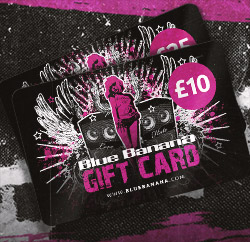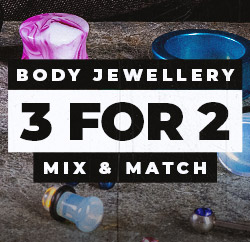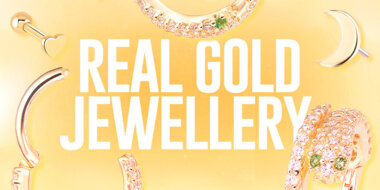Making sure you choose the right piercing jewellery for fresh piercings can make such a difference in how your piercing heals. Biocompatible material such as titanium is often recommended for a range of piercings to help them heal quickly. For more information about the types of jewellery you need and when you can change it, find all the answers to your new piercing FAQs below.
When can you change a new piercing?
Before you can change to new jewellery, make sure you have allowed your new piercing to heal with the jewellery that you were pierced with for the full recommended time. This varies depending on the piercing type. There are usually only two instances where this may differ. Firstly, if you have difficulty healing your piercing with a certain type of material or have an allergic reaction to your piercing jewellery then it is important to choose a different type with the help of your piercer. Secondly, if you have been pierced with a longer piece of jewellery to allow for swelling and are ready to change to a shorter bar. This can be beneficial to do once the swelling has gone down as it helps to reduce the chance of catching your jewellery if the bar is shorter.
How do you know if a piercing is healed?
Just because the recommended healing time is over, does not necessarily mean your piercing is healed and you should change your piercing jewellery straight away. Everyone’s body reacts differently and some take longer than others to heal. If your piercing is still tender or getting a crust daily then you may want to wait a little longer until it feels like it has healed further before changing your jewellery. If you ever do experience problems with healing your piercing, you can visit a Blue Banana Piercing Studio for advice.
If you have a new piercing make sure that you leave your jewellery in all the time. For this reason, we recommend buying some duplicate piercing jewellery or even some extra add on balls just in case. While a daily check of your piercing jewellery should help to keep it securely in place, sometimes the jewellery becomes loose and may even fall out. Save yourself scrabbling around trying to find a tiny piercing ball in a panic by making sure you have a backup on hand.
Changing Your Piercing Jewellery For Your New Piercing
It can feel like you have waited an eternity to be able to try some new piercing jewellery. For many types of piercing, your ultimate goal may be to change to a piercing hoop but allowing your body time to heal will help you to enjoy your piercing in the long term. Changing to a hoop too quickly can cause piercing bumps and discomfort as the shape of the jewellery is different from the straight bar you are likely to have been wearing in piercings such as ear cartilage and lip. A ring may also move more than you are used to with a jewellery bar. If you are changing the jewellery in your new piercing, start with a simple change such as the same type of piercing jewellery in a different colour.
Consider the weight of the jewellery you are wearing. Heavy accessories and materials or large jewellery may not be the ideal first switch for your piercing. Think about the activities you do in daily life. The larger or more intricate the piercing jewellery, the more likely it will catch on clothing, hair, headphones, and other everyday objects. With piercings such as ear lobes and belly buttons, start simply by adding a bar with a cute gem and work your way up to dangly accessories.
Once your piercing has healed, you may be ready to try wearing a ring. If you have a type of piercing that can support a jewellery hoop, consider options such as BCRs and Segment rings as they are easy to insert and maintain. Initially, avoid jewellery such as seamless rings that are harder to insert and have a break in the ring.
If you are intending to stretch your new piercing then make sure to wait until you are completely sure your piercing has healed. Leave it for longer than the recommended healing time and consider consulting a piercer before starting to stretch your piercing. Being patient always pays off in the long run and will give you a better chance at successfully stretching your piercing.
Best Material For New Piercings
The next element to consider is the jewellery material type. Sticking to a high grade piercing material such as titanium will help your piercing to continue healing smoothly. Getting the best metal for new piercings is incredibly important as this can affect healing time and success. Choosing a material that is too porous can lead to difficulty cleaning your piercing and even infection, choosing non-durable or non hypoallergenic jewellery may slow down healing too, and choosing jewellery that has nickel in it can cause problems as many people are sensitive to this metal. Here’s a quick breakdown of the common jewellery material types.
Is titanium metal good for new piercings?
Titanium piercing jewellery is the best jewellery for healing piercings if it is implant grade. Titanium for piercings is good for new piercings because it is durable, biocompatible and hypoallergenic. This is the best metal for daith piercing, ear cartilage piercings, lip piercings, ear lobe piercings, nipple piercings, eyebrow piercings, belly button piercing, and more.
Is surgical steel good for fresh piercings?
While high grade surgical steel has amazing durability some people do have sensitivities to it. It may be best saved until your piercing is healed if you have sensitive skin or are slow to heal. For some people with known allergies, it is best avoided altogether.
Can you use gold or silver in a new piercing?
While our instincts may tell us that precious metals such as gold and silver should be great for healing it is not always the case. These soft metals easily get nicks and scratches on the surface which become the perfect places for germs to get trapped making your piercing harder to clean and heal.
What earrings to wear when first pierced?
The earrings for newly pierced ears that will be used by your piercer usually have hypoallergenic and durable qualities as well as being biocompatible to help your new ear lobe or cartilage piercing to heal quickly. Biocompatible materials are less likely to be recognised as foreign objects by the body and therefore less likely to reject. The best earrings for newly pierced ears are titanium bars because the material has all these qualities. Choosing a simple design for your first earring studs such as a smooth labret or earrings with a small gemstone will help make the cleaning process much easier as there will be fewer places for bacteria to build. The best earrings for new piercings will have a straight bar, will be lightweight, will be made of a high grade material, and may have extra length to allow for swelling.
If you are new to piercing it can seem quite daunting but it is worth remembering that Blue Banana performs hundreds of piercings every day that heal successfully. With the right care and jewellery, you will have nothing to worry about. Our years of experience will help us to troubleshoot any problems you experience along the way but with high quality jewellery and expert piercers in our studios, you can easily get your new piercing and get answers to additional questions you may have.






















